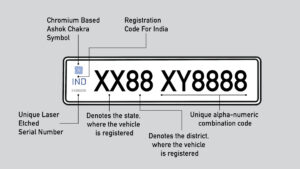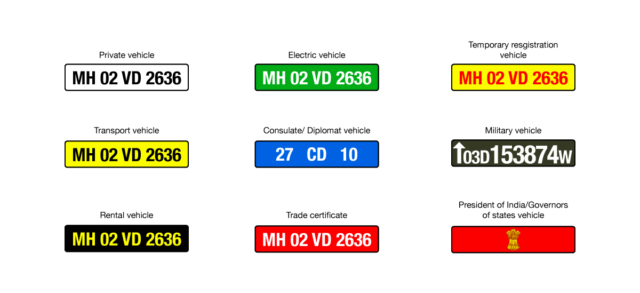You may have seen various coloured number plates for different kinds of vehicles. But, ever wondered what these colours mean?
Well, let us tell you that various types of number plates bear distinctive meanings depending on the type of vehicle. Therefore, go ahead and read about different types of number plates before you move on to buy your first motor vehicle.
What is a ‘Number Plate’?
A vehicle license plate is commonly known as ‘a number plate’. It is a metal plate which is attached to a vehicle and has the official registration number of a vehicle embossed on it. While it may seem like random numbering, the official license plate number in India consists of 4 different parts, each of which has a specific purpose. Number plates are placed at the front and back of the vehicle and help anyone to identify a vehicle.

Variation Of Format
Certain states opt for a unique format, where the first 0 of the district court is omitted and replaced with a category letter. This refers to the category of the vehicle,
- C for cars & SUVs,
- S for two-wheelers,
- E for electric vehicles,
- P for passenger vehicles, i.e. buses,
- R for three-wheeler rickshaws,
- T for tourist licensed vehicles,
- V for vans and pick-up trucks and
- Y for vehicles for hire.
- There are 8 colours of number plates identified by the Indian government.
- Blue number plates have country code instead of state code.
- Red number plates are valid for only 1 month.
- All vehicles(motorised) in India have a registration or licence number. The RTO issues a vehicle registration plate number aka number plate for each vehicle.
In India, you would come across 8 different types of number plates. These are –
- White number plate
- Yellow number plate
- Green number plate
- Red number plate
- Blue number plate
- Black number plate
- Number plate with an upward-pointing arrow
- Red number plate with the emblem of India
Please read the next section to understand these different styles of number plates and their meaning.
What Do the Unique Colours of Number Plates Stand For?
Some vehicles have different colour combinations for number plates. They could be white, yellow, blue and black colour plates. Each colour signifies a specific purpose.
- White: A white number plate with black text refers to a private vehicle. This vehicle cannot be used for commercial purposes.
- Yellow: A yellow number plate with black text is assigned to commercial vehicles such as taxis and trucks. The truck/taxi driver requires an official permit in order to drive a commercial vehicle.
- Blue: A blue number plate is given to a vehicle which is being used by foreign delegates, these have white text instead of black. It is criteria for them to show the country code, which replaces the state code.
- Black: Black number plates with yellow text are commercial vehicles which have a private owner but have been rented out for commercial purposes. In such a case a commercial driving permit is not mandatory.
- Red: Red is used for vehicles which seats the President of India and various State Governors. Such a vehicle replaces the license number with the Emblem of India, embossed in gold.
- Upward arrow: A military vehicle follows a unique system of its own, it uses a broad arrow as a prefix for the number, and replaces a state code with digits resembling the year in which the vehicle was procured. These vehicles are registered with the Ministry of Defence, New Delhi.
- Number plate with upward-pointing arrow-If you have closely observed a military vehicle, you could notice that the number plates attached to the vehicle have a unique style. The numbers found on those plates are registered under the Ministry of Defence. The first and third upward-pointing arrow of the type of license plates is known as Broad Arrow.These upward-pointing arrows are used in many parts of the British Commonwealth. The two digits immediately after the arrow point to the year the military vehicle was procured. Next comes the base code, which is followed by the serial number. The penultimate letter of the license number refers to the class of the vehicle.
- Red number plate with the emblem of India- This is a very special kind of number plate and comes with the emblem of India branded in golden colour.
As a modern Indian citizen, we should be aware of all the variations used in license numbers across the nation. Also about the various licenses and documents which are necessary in order to officially register a new vehicle and obtain the license plate. The system of license plate coding has evolved from time to time, as the number of motor vehicles in this country continues to rise.
Necessity for Registration ?
No person shall drive any Motor Vehicle and no owner of Motor Vehicle shall cause or permit the vehicle to be driven in any public place or any other place, unless the vehicle is Registered in accordence with Chapter 4 of IMV Act 1988.
Registration where to be made ?
Every owner of Motor Vehicle shall cause the Vehicle to be Registered by a Registrating Authority in whose Jurisdiction he has residence or place of business where the vehicle is normally kept.
Laws related to number plates in India
According to the Motors Vehicles Act of 1988, all motorised vehicles running on Indian roads must have an RTO registration and a valid license plate.
The Ministry of Roads and Highways (MoRTH) has brought about some changes in the existing rules related to the vehicle registration plate to restrict fraudulent activities as well as to eliminate any confusion.
The changes in the rules were made after the 1989 amendment. Below are the updates that came into effect from 1st October 2020.
- As per the new update, driving new motor vehicles with a paper-printed temporary registration number will be considered an offense.
- Temporary license plates will no longer follow the previous colour scheme. Instead, it will come with red alpha numerals on a yellow background.
- MoRTH has discarded the presence of any characters except the basic English letters and Arabic numerals. In addition, the new update has banned the usage of any regional language, including VIP numbers sold or auctioned by the various states or Union Territories.
- Further, The Ministry of Roads and Highways has also upgraded the Central Motors Vehicles Rules (CMVR). The new rule states the size, thickness and spacing between the characters in the number plate. As per the new rule, the sizes of the three parameters are 65 mm, 10 mm, and 10 mm, respectively. Please note that these rules are applicable on all motor vehicles barring the two and three-wheeled vehicles.
- The new update also includes BS-VI four-wheelers. These vehicles will have to bear a green coloured layer of 1 cm on the number plate. Moreover, these rules will be applicable to four-wheelers running in petrol/diesel/CNG.
- BS-VI four-wheelers will also have a sticker attached to the green layer. The vehicles running in diesel will have an orange coloured sticker and the vehicles running in CNG and petrol will bear a blue coloured sticker.
Till now, we have discussed the colour scheme of different types of number plates. However, other vehicle licensing plates are distinguished based on validity (temporary, permanent) and security.
Take a look!
- Temporary registration plate-As the name suggests, a temporary vehicle registration plate is assigned to a brand new vehicle that is yet to get registered by the respective RTO. The temporary registration number plate comes with a validity period of one month. As per the updated norms released by MoRTH, all temporary registration plates will come with colour-coded alpha-numerals depending on the vehicle type.
- Permanent registration plate-According to Section 39 of the Motor Vehicles Act 1988, all vehicle owners must get their permanent registration number from the respective RTO before plying on Indian roads. A permanent registration number is an identification number that is unique to every vehicle.
- High security registration plates-As per the Central Motor Vehicles Rule 1989, all registered vehicles after 1st April 2019 must bear a High security registration plate or (HSRP). This new norm is applicable for all old vehicles having old number plates. High security registration plate is made with aluminium and features a unique laser-etched code below the International Registration Code of India (IND) and Ashok Chakra hologram.
- In addition, this number plate comes with snap-locks which makes it non-reusable after an attempt to tamper it. High security registration plate is standard across India and aims to maintain a digitised record of all registered vehicles.
- Fancy number plate-Fancy number plates enable your vehicle to bear a customised number plate in terms of font and size. However, before you opt for fancy number plates, make sure you learn about the new norms related to the personalised option.
Do you know that driving with a number plate displaying ‘Applied For’ or without a number plate can incur a penalty of Rs. 100 under section CMVR 105(2) (ii) and Rs.4500 under 177 Motor Vehicle Act, respectively?
Now that you know about the penalty charges and different types of number plates as per the colour scheme, applying for a vehicle registration plate will not be a hassle anymore.







